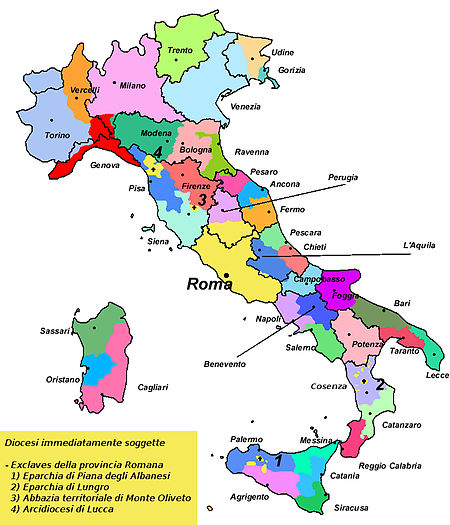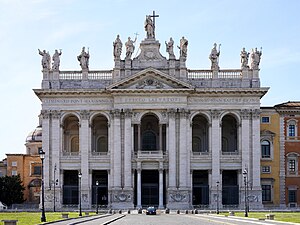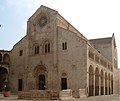List of Catholic dioceses in Italy
The following is the List of the Catholic dioceses in Italy. As of May 2017[update], the Catholic Church in Italy is divided into sixteen ecclesiastical regions. While they are similar to the 20 civil regions of the Italian state, there are some differences. Most ecclesiastical regions are in turn divided into a number of ecclesiastical provinces. The provinces are in turn divided into a number of dioceses. The sovereign state of Vatican City is part of the metropolitan province of Rome. A metropolitan bishop exercises a degree of leadership over a group of dioceses that are loosely subject (suffragan) to the care of the metropolitan see. This list excludes those archdioceses, dioceses and ecclesiastical territories that are immediately subject to the Holy See.
There are 227 sees ('particular churches'), most of which are dioceses led by a bishop. A diocese that is led by an archbishop is known as an archdiocese. There are 40 Metropolitan archdioceses which serve as the seat of an ecclesiastical province. This number includes the Holy See and the Patriarchate of Venice. There are also four archdioceses which are non-metropolitan, having been demoted by papal decree. This brings the number of archbishops in Italy and Vatican City to 44 (i.e. 40 + 4).
All the sees belong to the Latin Church apart from three Eastern Catholic sees of the Italo-Albanian Catholic Church that use the Byzantine Rite in the Albanian language. All sees of the Latin Church use the Roman Rite apart from the Metropolitan Archdiocese of Milan, which mainly uses the Ambrosian Rite.
Episcopal Conference of Italy
[edit]
| Map Code |
Ecclesiastical Region |
Ecclesiastical Province |
|---|---|---|
| 1 | Abruzzo-Molise | |
| L'Aquila in Abruzzo | ||
| Chieti-Vasto in Abruzzo | ||
| Pescara-Penne in Abruzzo | ||
| Campobasso-Boiano in Molise | ||
| 2 | Basilicata | |
| Potenza-Muro Lucano-Marsico Nuovo | ||
| 3 | Calabria | |
| Calabria-Bova | ||
| Catanzaro-Squillace | ||
| Cosenza-Bisignano | ||
| 4 | Campania | |
| Salerno-Campagna-Acerno | ||
| Benevento | ||
| Naples | ||
| 5 | Emilia-Romagna | |
| Bologna | ||
| Modena-Nonantola | ||
| Ravenna-Cervia | ||
| 6 | Lazio | |
| Rome | ||
| 7 | Liguria | |
| Genoa | ||
| 8 | Lombardy | |
| Milan | ||
| 9 | Marche | |
| Ancona-Osimo | ||
| Fermo | ||
| Pesaro | ||
| 10 | Piedmont | |
| Turin including Aosta Valley | ||
| Vercelli in Piedmont | ||
| 11 | Puglia | |
| Bari-Bitonto | ||
| Foggia-Bovino | ||
| Lecce | ||
| Taranto | ||
| 12 | Sardinia | |
| Cagliari | ||
| Oristano | ||
| Sassari | ||
| 13 | Sicily | |
| Agrigento | ||
| Catania | ||
| Messina-Lipari | ||
| Palermo | ||
| Syracuse | ||
| 14 | Tuscany | |
| Florence | ||
| Pisa | ||
| Siena-Colle di Val d'Elsa-Montalcino | ||
| 15 | Triveneto | |
| Gorizia in Friuli-Venezia Giulia | ||
| Udine in Friuli-Venezia Giulia | ||
| Trento in Trentino-Alto Adige/Südtirol | ||
| Venice in Veneto | ||
| 16 | Umbria | |
| Perugia-Città della Pieve |
Exempt
[edit]The following are immediately Subject to the Holy See, despite not being in the Pope's Ecclesiastical Province of Rome.
- non-Metropolitan Archdiocese of Lucca
- non-Metropolitan Archdiocese of Spoleto-Norcia
- Diocese of Orvieto-Todi
- Diocese of Terni-Narni-Amelia
- Territorial Abbey of Monte Oliveto Maggiore
- Military Ordinariate of Italy
- Personal Prelature of Opus Dei
(Byzantine Rite, the only non-Latin dioceses in Italy)
- Eparchy of Lungro
- Eparchy of Piana degli Albanesi
- Territorial Abbacy of Santa Maria of Grottaferrata
Ecclesiastical Region of Abruzzo-Molise
[edit]The ecclesiastical provinces of L'Aquila, Chieti-Vasto and Pescara-Penne are mainly situated in the civil region of Abruzzo while Campobasso-Boiano is situated in Molise.
Ecclesiastical Province of L'Aquila
[edit]Ecclesiastical Province of Chieti-Vasto
[edit]Ecclesiastical Province of Pescara-Penne
[edit]Ecclesiastical Province of Campobasso-Boiano
[edit]- Metropolitan Archdiocese of Campobasso-Boiano
Ecclesiastical Region of Basilicata
[edit]Ecclesiastical Province of Potenza-Muro Lucano-Marsico Nuovo
[edit]Ecclesiastical Region of Calabria
[edit]Ecclesiastical Province of Reggio Calabria-Bova
[edit]Ecclesiastical Province of Catanzaro-Squillace
[edit]- Metropolitan Archdiocese of Catanzaro-Squillace
Ecclesiastical Province of Cosenza-Bisignano
[edit]- Metropolitan Archdiocese of Cosenza-Bisignano
Ecclesiastical Region of Campania
[edit]Ecclesiastical Province of Salerno-Campagna-Acerno
[edit]- Metropolitan Archdiocese of Salerno-Campagna-Acerno
Ecclesiastical Province of Benevento
[edit]- Metropolitan Archdiocese of Benevento
Ecclesiastical Province of Naples
[edit]- Metropolitan Archdiocese of Naples
- Archdiocese of Capua
- Archdiocese of Sorrento-Castellammare di Stabia
- Diocese of Acerra
- Diocese of Alife-Caiazzo
- Diocese of Aversa
- Diocese of Caserta
- Diocese of Ischia
- Diocese of Nola
- Diocese of Pozzuoli
- Diocese of Sessa Aurunca
- Diocese of Teano-Calvi
- Territorial Prelature of Pompei o Beatissima Vergine Maria del SS.mo Rosario
Ecclesiastical Region of Emilia-Romagna
[edit]Ecclesiastical Province of Bologna
[edit]- Metropolitan Archdiocese of Bologna
Ecclesiastical Province of Modena-Nonantola
[edit]- Metropolitan Archdiocese of Modena-Nonantola
Ecclesiastical Province of Ravenna-Cervia
[edit]Ecclesiastical Region of Lazio
[edit]Ecclesiastical Province of Rome
[edit]
- Diocese of Rome
- Suburbicarian See of Albano
- Suburbicarian See of Frascati
- Suburbicarian See of Palestrina
- Suburbicarian See of Porto-Santa Rufina
- Suburbicarian See of Sabina-Poggio Mirteto
- Suburbicarian See of Velletri-Segni
- Archdiocese of Gaeta
- Diocese of Anagni-Alatri
- Diocese of Civita Castellana
- Diocese of Civitavecchia-Tarquinia
- Diocese of Frosinone-Veroli-Ferentino
- Diocese of Latina-Terracina-Sezze-Priverno
- Diocese of Rieti
- Diocese of Sora-Aquino-Pontecorvo
- Diocese of Tivoli
- Diocese of Viterbo
- Territorial Abbey of Montecassino
- Territorial Abbey of Subiaco
Ecclesiastical Region of Liguria
[edit]Ecclesiastical Province of Genoa
[edit]- Metropolitan Archdiocese of Genoa
Ecclesiastical Region of Lombardy
[edit]Ecclesiastical Province of Milan
[edit]- Metropolitan Archdiocese of Milan
Ecclesiastical Region of Marche
[edit]Ecclesiastical Province of Ancona-Osimo
[edit]- Metropolitan Archdiocese of Ancona-Osimo
Ecclesiastical Province of Fermo
[edit]- Metropolitan Archdiocese of Fermo
Ecclesiastical Province of Pesaro
[edit]- Metropolitan Archdiocese of Pesaro
Ecclesiastical Region of Piedmont
[edit]Ecclesiastical Province of Turin
[edit]- Metropolitan Archdiocese of Turin
Ecclesiastical Province of Vercelli
[edit]- Metropolitan Archdiocese of Vercelli
Ecclesiastical Region of Puglia
[edit]Ecclesiastical Province of Bari-Bitonto
[edit]- Metropolitan Archdiocese of Bari-Bitonto
Ecclesiastical Province of Foggia-Bovino
[edit]- Metropolitan Archdiocese of Foggia-Bovino
Ecclesiastical Province of Lecce
[edit]- Metropolitan Archdiocese of Lecce
Ecclesiastical Province of Taranto
[edit]- Metropolitan Archdiocese of Taranto
Ecclesiastical Region of Sardinia
[edit]Ecclesiastical Province of Cagliari
[edit]Ecclesiastical Province of Oristano
[edit]- Metropolitan Archdiocese of Oristano
Ecclesiastical Province of Sassari
[edit]- Metropolitan Archdiocese of Sassari
Ecclesiastical Region of Sicily
[edit]Ecclesiastical Province of Agrigento
[edit]Ecclesiastical Province of Catania
[edit]Ecclesiastical Province of Messina-Lipari-Santa Lucia del Mela
[edit]Ecclesiastical Province of Palermo
[edit]- Metropolitan Archdiocese of Palermo
Ecclesiastical Province of Siracusa (Syracuse)
[edit]- Metropolitan Archdiocese of Siracusa
Ecclesiastical Region of Tuscany
[edit]Ecclesiastical Province of Firenze (Florence)
[edit]- Metropolitan Archdiocese of Florence
Ecclesiastical Province of Pisa
[edit]Ecclesiastical Province of Siena-Colle di Val d'Elsa-Montalcino
[edit]- Metropolitan Archdiocese of Siena-Colle di Val d'Elsa-Montalcino
Ecclesiastical Region of Triveneto
[edit]In the ecclesiastical region of Triveneto, there are two ecclesiastical provinces of that are situated in the civil region of Friuli-Venezia Giulia (Gorizia and Udine); one province that is mainly situated in the civil region of Trentino-Alto Adige/Südtirol (Trento); one province that is mainly situated in the civil region of Veneto (Venice).
Ecclesiastical Province of Gorizia
[edit]- Metropolitan Archdiocese of Gorizia
Ecclesiastical Province of Udine
[edit]- Metropolitan Archdiocese of Udine
Ecclesiastical Province of Trento
[edit]- Metropolitan Archdiocese of Trento
Ecclesiastical Province of Venice
[edit]Ecclesiastical Region of Umbria
[edit]Ecclesiastical Province of Perugia-Città della Pieve
[edit]- Metropolitan Archdiocese of Perugia-Città della Pieve
Former prelatures
[edit]Titular Prelatures
[edit]- Titular Archiepiscopal Sees :
- Metropolitan : Patriarchate of Aquileia, Patriarchate of Grado
- other : Archdiocese of Gradisca
- Titular Episcopal Sees (158): Acquapendente, Æca, Agropoli, Alessano, Altino, Amiterno, Anglona, Anzio, Aquaviva, Arna, Arpi, Asolo, Atella, Aveia, Bagnoregio, Belcastro, Bettona, Bevagna, Biccari, Bisarcio, Bitetto, Blanda, Blera, Bolsena, Bomarzo, Brescello, Buxentum, Campli, Canne, Canosa, Caorle, Capo della Foresta, Capri, Carini, Carinola, Carmeiano, Castello, Castro, Castro di Puglia, Castro di Sardegna, Caudium, Celano, Cerenzia, Cerveteri, Città Ducale, Civitanova, Civitate, Claterna, Cuma, Dolia, Dragonara, Eclano, Egnazia Appula, Equilio, Eraclea, Erdonia, Faleri, Falerone, Ferento, Fidene, Fiorentino, Fondi, Forconio, Fordongianus, Forlimpopoli, Formia, Foro Flaminio, Frigento, Gabi, Galazia in Campania, Gallese, Galtellì, Grumentum, Guardialfiera, Isola, Labico, Lavello, Lentini, Lesina, Lettere, Lilibeo, Lorium, Luni, Malamocco, Martana, Martirano, Massa Lubrense, Minervino Murge, Minori, Minturno, Miseno, Montecorvino, Montefiascone, Montemarano, Monterano, Monteverde, Mottola, Nepi, Nomento, Numana, Oderzo, Ofena, Orte, Ostra, Otricoli, Ottana, Passo Corese, Pausula, Pesto, Plestia, Ploaghe, Polignano, Populonia, Potenza Picena, Ravello, Roselle, Sabiona, Sala Consilina, Salpi, San Leone, Santa Giusta, Satriano, Scala, Sepino, Sorres, Spello, Strongoli, Subaugusta, Suelli, Sulci, Sutri, Taormina, Tauriano, Termini Imerese, Tharros, Thurio, Tindari, Torcello, Tortiboli, Tre Taverne, Treba, Trevi, Trevi nel Lazio, Trevico, Tricala, Troina, Tronto, Tuscania, Umbriatico, Urbisaglia, Velia, Vescovìo, Vibo Valentia, Vico Equense, Voghenza, Volturno, Vulturara, Zuglio
- Titular Abbacies (?nullius) (all 10 united to current dioceses) : Farfa, Fontevivo, Nonantola, Pomposa, San Colombano, San Martino al Monte Cimino, San Michele Arcangelo di Montescaglioso, San Salvatore Maggiore, Santa Maria di Polsi, Santissimo Salvatore
Gallery of Archdioceses
[edit]-
The seat of the Archdiocese of Agrigento is Cattedrale Metropolitana di San Gerlando.
-
The seat of the Archdiocese of Ancona-Osimo is Basilica Cattedrale Metropolitana di San Ciriaco.
-
The co-seat of the Archdiocese of Ancona-Osimo is Basilica Concattedrale di S. Leopardo.
-
The seat of the Archdiocese of Bari-Bitonto is Cattedrale di San Sabino.
-
The co-seat of the Archdiocese of Bari-Bitonto is Cattedrale di San Valentino.
-
The seat of the Archdiocese of Benevento is Cattedrale di Santa Maria Assunta.
-
The seat of the Archdiocese of Bologna is Cattedrale Metropolitana di San Pietro.
-
The co-seat of the Archdiocese of Campobasso-Boiano is Concattedrale di S. Bartolomeo(Boiano).
-
The seat of the Archdiocese of Cagliari is Cattedrale di Santa Maria e Santa Cecilia.
-
The seat of the Archdiocese of Catanzaro-Squillace is Cattedrale di S. Maria Assunta.
-
The co-seat of the Archdiocese of Catanzaro-Squillace is Concattedrale di S. Maria Assunta(Squillace).
-
The seat of the Archdiocese of Catania is Cattedrale di Sant'Agata.
-
The seat of the Archdiocese of Chieti-Vasto is Cattedrale di S. Giustino.
-
The co-seat of the Archdiocese of Chieti-Vasto is Concattedrale di S. Giuseppe(Vasto).
-
The seat of the Archdiocese of Cosenza-Bisignano is Cattedrale di S. Maria Assunta.
-
The seat of the Archdiocese of Fermo is Basilica Cattedrale di Maria SS. Assunta in Cielo.
-
The seat of the Archdiocese of Florence is Basilica di Santa Maria del Fiore.
-
The seat of the Archdiocese of Foggia-Bovino is Cattedrale di S. Maria Assunta in Cielo.
-
The co-seat of the Archdiocese of Foggia-Bovino is Basilica Concattedrale di S. Maria Assunta(Bovino).
-
The seat of the Archdiocese of Genoa is Cattedrale di San Lorenzo.
-
The seat of the Archdiocese of Gorizia is Cattedrale di Ss. Ilario e Taziano.
-
The seat of the Archdiocese of L'Aquila is Cattedrale di SS. Massimo e Giorgio.
-
The seat of the Archdiocese of Lecce is Cattedrale di Maria SS. Assunta.
-
The seat of the Archdiocese of Lucca is Cattedrale di S. Martino.
-
The seat of the Archdiocese of Messina-Lipari-Santa Lucia del Mela is Basilica Cattedrale di S. Maria SS. Assunta.
-
The co-seat of the Archdiocese of Messina-Lipari-Santa Lucia del Mela is Concattedrale Archimandritato del Santissimo Salvatore(Messina).
-
The co-seat of the Archdiocese of Messina-Lipari-Santa Lucia del Mela is Concattedrale di S. Bartolomeo(Lipari).
-
The co-seat of the Archdiocese of Messina-Lipari-Santa Lucia del Mela is Concattedrale di S. Maria Assunta(San Lucia) .
-
The seat of the Archdiocese of Milan is Cattedrale di S. Maria Nascente.
-
The seat of the Archdiocese of Modena-Nonantola is Basilica Cattedrale di S. Maria Assunta.
-
The co-seat of the Archdiocese of Modena-Nonantola is Basilica Abbaziale di San Silvestro I Papa(Nonantola).
-
The seat of the Archdiocese of Naples is Cattedrale di Santa Maria Assunta.
-
The seat of the Archdiocese of Oristano is Cattedrale di S. Maria Assunta.
-
The seat of the Archdiocese of Palermo is Cattedrale di l’Assunzione di Maria.
-
The seat of the Archdiocese of Perugia-Città della Pieve is Cattedrale di S. Lorenzo.
-
The seat of the Archdiocese of Pesaro is Basilica Cattedrale di S. Maria Assunta.
-
The seat of the Archdiocese of Pescara-Penne is Cattedrale di S. Cetteo Vescovo e Martire.
-
The seat of the Archdiocese of Pisa is Cattedrale di S. Maria Assunta.
-
The seat of the Archdiocese of Potenza-Muro Lucano-Marsico Nuovo is Basilica Cattedrale di S. Maria Assunta e S. Gerardo Vescovo.
-
The seat of the Archdiocese of Ravenna-Cervia is Cattedrale di Risurrezione di N.S. Gesù Cristo.
-
The co-seat of the Archdiocese of Ravenna-Cervia is Cattedrale di S. Pietro(Cervia).
-
The seat of the Archdiocese of Reggio Calabria-Bova is Basilica Cattedrale di Maria SS. Assunta in Cielo.
-
The seat of the Diocese of Rome is Archbasilica of St. John Lateran
-
The seat of the Archdiocese of Sassari is Cattedrale di S. Nicola di Bari.
-
The seat of the Archdiocese of Salerno-Campagna-Acerno is Cattedrale-Basilica di S. Matteo.
-
The co-seat of the Archdiocese of Salerno-Campagna-Acerno is Concattedrale-Basilica di S. Maria della Pace(Campagna).
-
The co-seat of the Archdiocese of Salerno-Campagna-Acerno is Concattedrale di S. Donato(Acerno).
-
The seat of the Archdiocese of Siena-Colle di Val d'Elsa-Montalcino is Cattedrale di S. Maria Assunta.
-
The co-seat of the Archdiocese of Siena-Colle di Val d'Elsa-Montalcino is the Cathedral of Ss. Marziale & Alberto.
-
The co-seat of the Archdiocese of Siena-Colle di Val d'Elsa-Montalcino is Concattedrale di S. Salvatore(Montalcino).
-
The seat of the Archdiocese of Siracusa is the Cathedral of the Nativity of Mary Most Holy.
-
The seat of the Archdiocese of Spoleto-Norcia is Cattedrale di Santa Maria Assunta.
-
The co-seat of the Archdiocese of Spoleto-Norcia is Concattedrale di S. Maria Argentea(Norcia).
-
The seat of the Archdiocese of Taranto is Basilica Cattedrale di S. Cataldo.
-
The seat of the Archdiocese of Turin is Cattedrale Metropolitana di S. Giovanni Battista.
-
The seat of the Archdiocese of Trento is Basilica Cattedrale di S. Vigilio Vescovo.
-
The seat of the Archdiocese of Udine is Cattedrale Metropolitana di S. Maria Annunziata.
-
The seat of the Archdiocese of Venice is Basilica Cattedrale Patriachale di S. Marco.
-
The seat of the Archdiocese of Vercelli is Cattedrale-Basilica di S. Eusebio.



























































